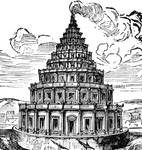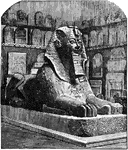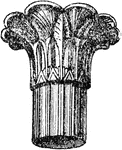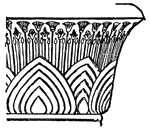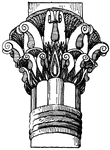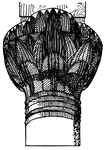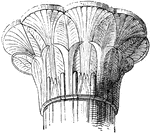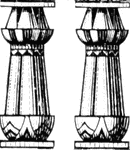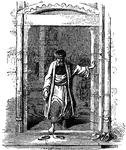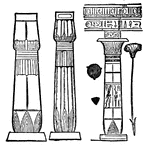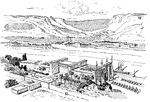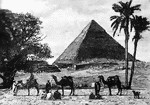This ClipArt gallery offers 138 illustrations of Egyptian architecture, including structures and styles commonly seen and used in Egyptian construction. Illustrations include pyramids, temples, obelisks, columns, and other distinctive elements of Egyptian architecture. See also the Egyptian Ornament ClipArt gallery.
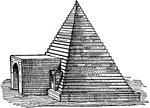
Tomb at Abydos
One, structural and pyramidal, is represented by many examples at Abydos, the most venerated of all…
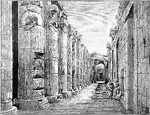
The Temple of Abydos
Built by Seti I and completed by his son Ramses II. The pillars in this temple contain carvings of very…
Architrave of Entablature over Doorway at the Great Temple at Philæ
An entablature refers to the superstructure of moldings and bands which lie horizontally above columns,…
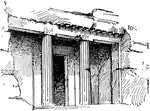
Tomb at Beni-Hassan
Beni Hasan (also written as Bani Hasan, or also Beni-Hassan) is a village in Middle Egypt about 25 km…
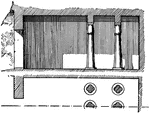
Section and Half-Plan of a Tomb at Beni-Hassan
Beni Hasan (also written as Bani Hasan, or also Beni-Hassan) is a village in Middle Egypt about 25 km…

A Capital from Karnak
"In their private dwellings the Egyptians sometimes used graceful columns and the true arch (both of…

Capital in the Temple at Denderah
In some temples the pillars have, in lieu of capital, the face of a goddess, probably of Isis, with…
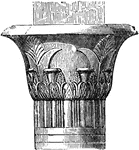
Capital in the Temple at Edfu
The capitals of the columns display an immense variety. The most beautiful have a crater-like form,…

Capital in the Temple at Edfu
The capitals of the columns display an immense variety. The most beautiful have a crater-like form,…
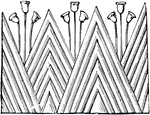
Capital Ornament in the Temple at Edfu
At the lower part of the capital there frequently occurs an ornament of diminishing triangles, resembling…

Capital Types
Figures a and b show the bell-shaped (campaniform) capital. Figure c is a palmiform capital.
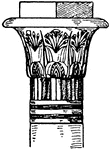
Egyptian Capital
The Egyptian capital is the upper termination of the column with opened papyrus flowers. It is found…

Egyptian Sarcophagus
A coffin or tomb of stone; a kind of stone chest, generally more or less ornamented for receiving a…
Front View of the Colossal Statue on a Pier at the Luxor Temple
Instead of columns, square piers are not infrequently introduced in the tombs. In structural buildings…
Profile of the Colossal Statue on a Pier at the Luxor Temple
Instead of columns, square piers are not infrequently introduced in the tombs. In structural buildings…
Column
"Columns are largely employed in the architecture of Egyptian temples. They are of various forms." —D'Anvers,…
Column
"Columns are largely employed in the architecture of Egyptian temples. They are of various forms." —D'Anvers,…
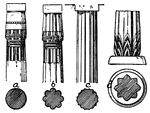
Column Types
Egyptian columns had shafts of three types: a) circular or cylindrical, b) clustered, c) polygonal or…
Hathor's Column
An illustration of a column with a craving of Hathor. In Egyptian mythology, Hathor (Pronounced Hah-Thor)…

Types of Columns
a, campaniform; b, clustered lotus column; c, simple lotus column; d, palm column; e, Hathor-headed…

Cornice of Entablature over Doorway at the Great Temple at Philæ
An entablature refers to the superstructure of moldings and bands which lie horizontally above columns,…

Deir-el-Bahri
"Temple of Deir-el-Bahri, conjectural restoration by Prof. E. Brune." — The Encyclopedia Britannica,…
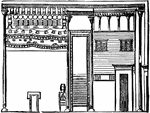
Egyptian Dwelling
"The houses of the artisans and husbandmen were generally of brick, and were as well furnished as the…

Temple of Edfu Plan
The Temple of Edfu is an ancient Egyptian temple located on the west bank of the Nile in the city of…
Temple of Edfu Section
The Temple of Edfu is an ancient Egyptian temple located on the west bank of the Nile in the city of…
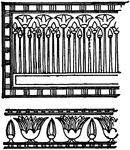
Egyptian Floral Ornament Form
Externally the temples presented only masses of unbroken wall; but these, as well as the pylons, were…

Egyptian Temple
Sleep temples are regarded by some as an early instance of hypnosis over 4000 years ago, under the influence…
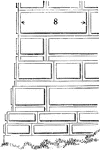
Elevation of Platform at Pasargadæ
The workmanship of the white marble columns, and of the large squared stones which are joined without…

Elliptical Arch
"Upright elliptical arch, sometimes called the egg-shaped arch, employed in Egyptian and Sassanian architecture."…
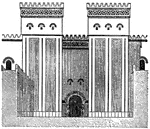
Facade
"Facade of the Great Hall of Columns of the Ptolemaic temple at Edfu." — The Encyclopedia Britannica,…

Private Dwelling Floor Plan
An illustration of a typical floor plan in an Egyptian private dwelling.

Mural Frieze-like Decoration from the Temple of Esneh
They are generally of smaller dimensions in the interior, so that the walls or columns of the same chamber…

The Great Pyramid of Giza
"The pyramid when completed had a height of 481 feet. It is now 451 feet high. Its base covers 13 acres.…

Pyramids of Gizeh
Two pyramids and a sphinx near Gizeh, Egypt, built during the 25th century. These three structures rank…

Great Hall of Karnak
"Restoration of the Great Hall of Karnak-- largest building of the Egyptian empire." -Breasted, 1914
